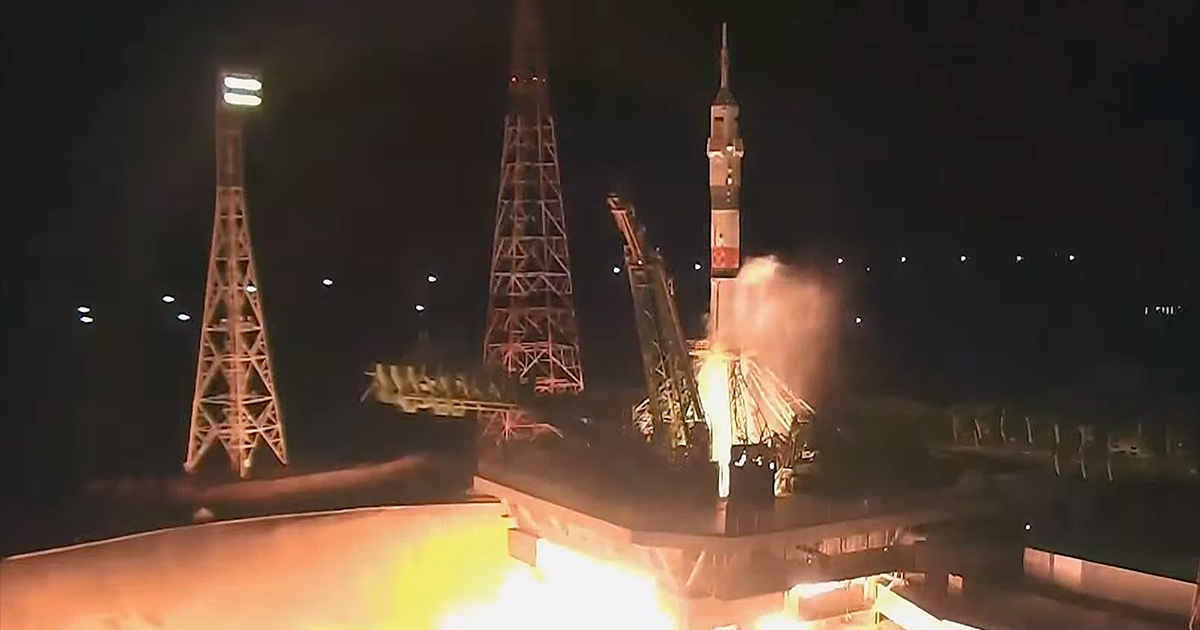Soyuz MS-24 Launches Crew for Extended Yearlong Stay on Space Station in Russia
On September 15, 2023, history was made as two Russian cosmonauts embarked on a year-long mission aboard the International Space Station (ISS). Oleg Kononenko and Nikolai Chub, representing the Russian federal space corporation Roscosmos, were joined by American astronaut Loral O’Hara from NASA. However, O’Hara will return to Earth after six months, while Kononenko and Chub will remain in space for an extended duration.
The trio launched from the Baikonur Cosmodrome in Kazakhstan on Russia’s Soyuz MS-24 spacecraft. Lift-off occurred at 11:44 a.m. EDT (1544 GMT or 8:44 p.m. local time) atop a Soyuz 2.1a rocket. As a lighthearted tradition, plush seagulls served as the crew’s zero-gravity indicator, floating when the Soyuz entered orbit. These seagulls were gifts from the director of the Chekhov Moscow Art Theatre, which Kononenko visited before the launch. Kononenko also brought along a flag and a fragment of a curtain to commemorate the 125th anniversary of the theater.
The Soyuz MS-24 took an expedited path to reach the ISS, with the crew scheduled to arrive and dock at the Rassvet mini-research module at about 2:56 p.m. EDT (1856 GMT) after just a two-orbit rendezvous. The spacecraft autonomously docked at 2:53 p.m. EDT (1853 GMT).
Upon arrival at the space station, Kononenko, Chub, and O’Hara joined Expedition 69, led by commander Sergey Prokopyev. The crew also includes cosmonauts Dmitry Petelin and Andrey Fedyaev from Roscosmos, NASA astronauts Frank Rubio and Jasmin Moghbeli, European Space Agency (ESA) astronaut Andreas Mogensen, and Japan Aerospace Exploration Agency (JAXA) astronaut Satoshi Furukawa. Expedition 70 will commence with the scheduled departure of Soyuz MS-23 on September 27, carrying Prokopyev, Petelin, and Rubio.
Kononenko and Chub’s extended stay in space allows for a short visit by Marina Vasileyeva, a former flight attendant representing the Republic of Belarus. Vasileyeva will travel on Soyuz MS-25 under an agreement with Roscosmos. After a week at the station, Vasileyeva will return to Earth alongside O’Hara and Soyuz MS-25 commander Oleg Novitsky. NASA astronaut Tracy Caldwell Dyson will launch with Novitsky and Vasileyeva, then return to Earth with Kononenko and Chub on Soyuz MS-25.
If Kononenko and Chub spend 365 days or more in space, they will become the eighth and ninth Russians to have lived in space for a year. Additionally, they will be the third and fourth cosmonauts to achieve this feat on the ISS. Notably, NASA astronaut Frank Rubio, who is departing on Soyuz MS-23, is the first and only American to have logged a year or more in space, accumulating a total of 371 days when he returns to Earth.
During their time aboard the ISS, Kononenko, Chub, and O’Hara will witness the arrival and departure of several visiting vehicles. They will conduct maintenance tasks and spacewalks to ensure the smooth functioning of the orbital complex. Furthermore, they will actively participate in hundreds of scientific experiments.
O’Hara expressed excitement about the upcoming activities during a pre-launch press conference, stating that they expect to be very busy. Two extravehicular activities (EVAs) are scheduled for mid-October, followed by the arrival of a SpaceX cargo Dragon, which will keep them occupied with scientific endeavors.
Kononenko, with his extensive experience as an engineer and cosmonaut, has been on four prior missions to the ISS. His previous stays include Expedition 17 in 2008, Expedition 30/31 in 2012, Expedition 44/45 in 2015, and Expedition 57/58/59 in 2019. Before this mission, he had already spent more than 736 days in space, making him the record holder for the most cumulative time spent in space by any human. By the end of this mission, Kononenko’s total time in space will exceed 1,000 days.
Chub, on the other hand, is embarking on his first spaceflight. Before his selection as a cosmonaut in 2012, he worked as a director at an astronautics firm and participated in the European Space Agency’s CAVES training program. He also served as a backup crew member for Soyuz MS-12 and MS-22.
O’Hara, a member of NASA’s 22nd group of astronauts known as “The Turtles,” previously worked on rocket and submersible development. In 2017, she was selected as an astronaut and is now the second astronaut to fly on a Russian Soyuz spacecraft under a seat-swap agreement between Roscosmos and NASA. O’Hara shared her lifelong passion for exploration and spaceflight, emphasizing that it encompasses her childhood dreams and desire to engage in challenging activities and study our planet.
Soyuz MS-24 represents Russia’s 70th Soyuz launch to the ISS since 2000 and the 153rd flight since 1967. As this mission commences, the world eagerly anticipates the discoveries and achievements that will unfold during this year-long stay in space.
